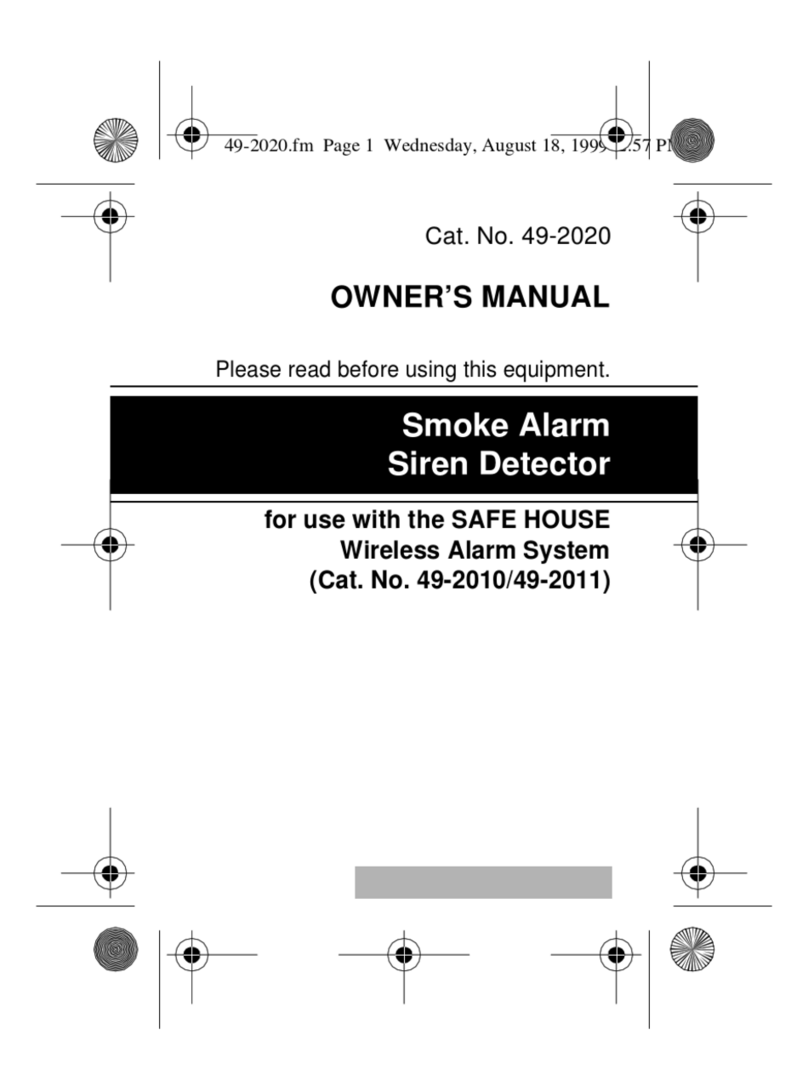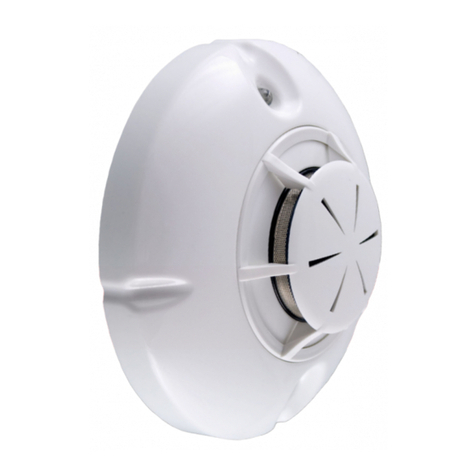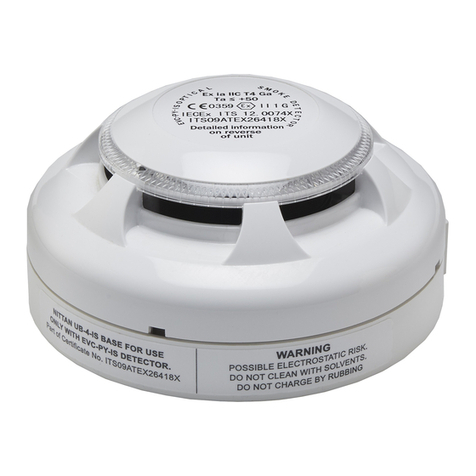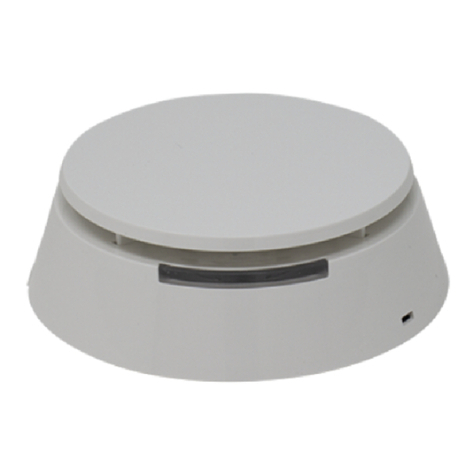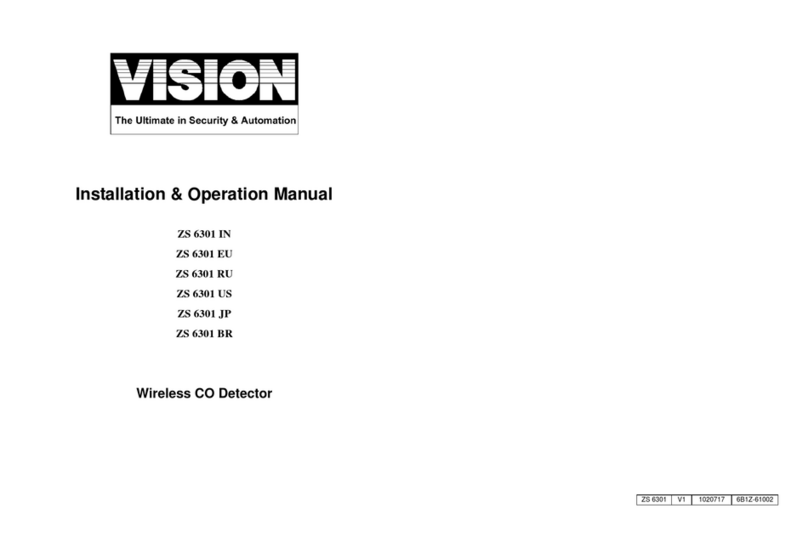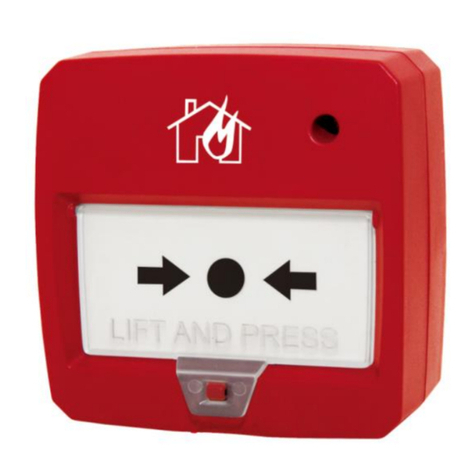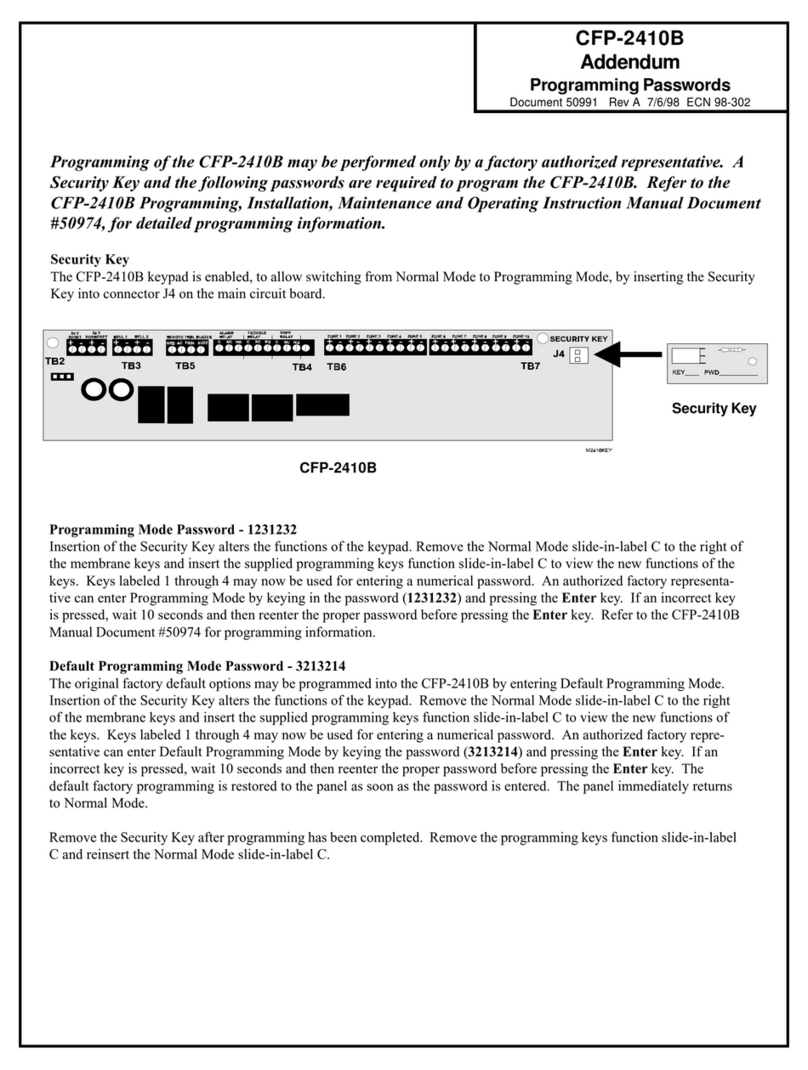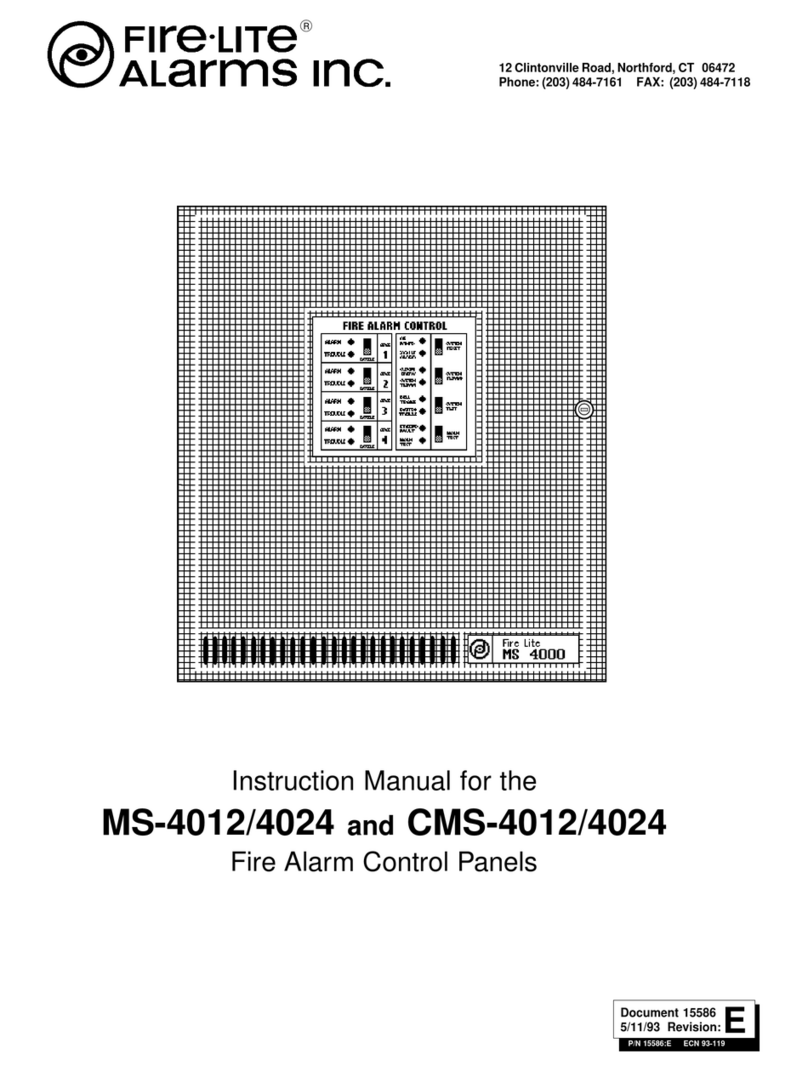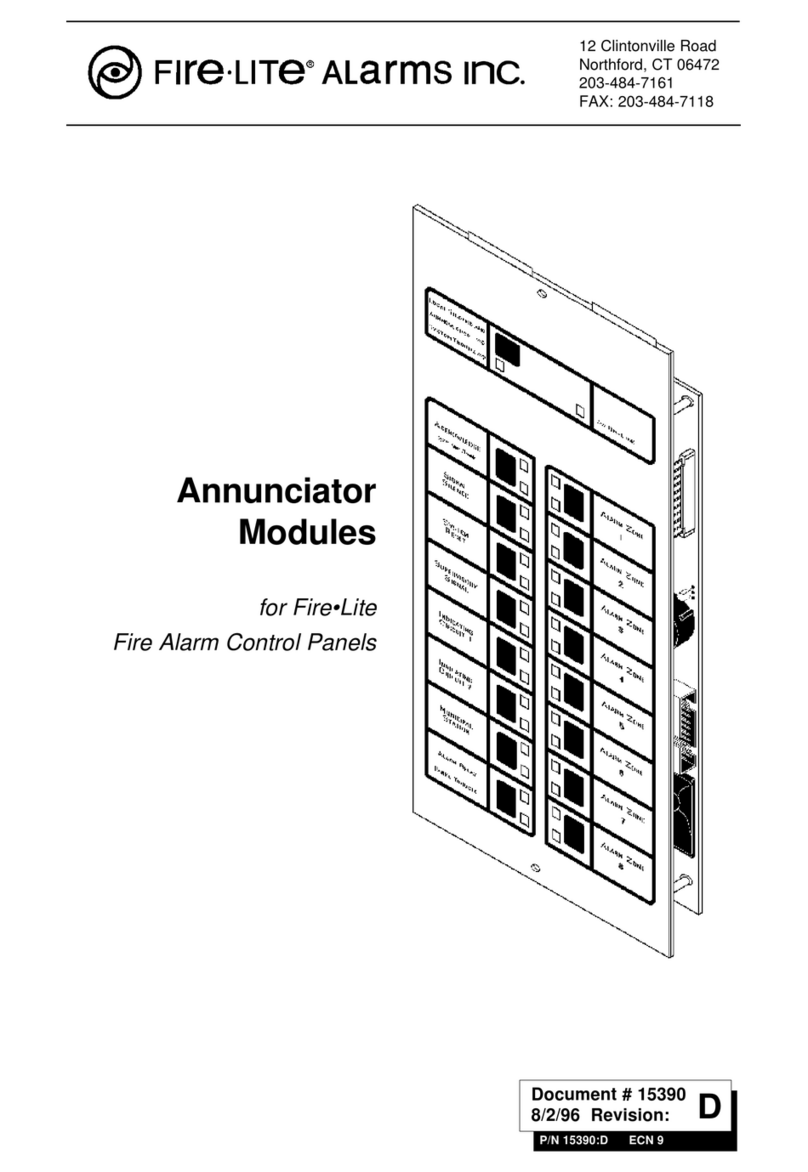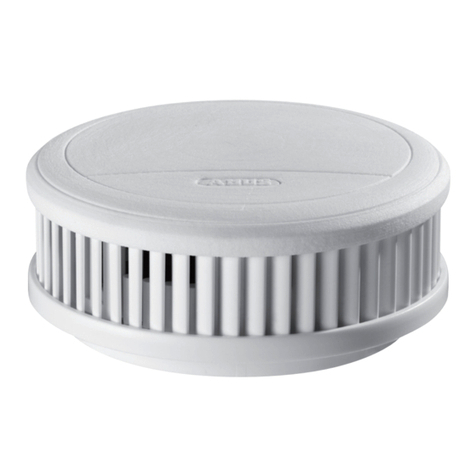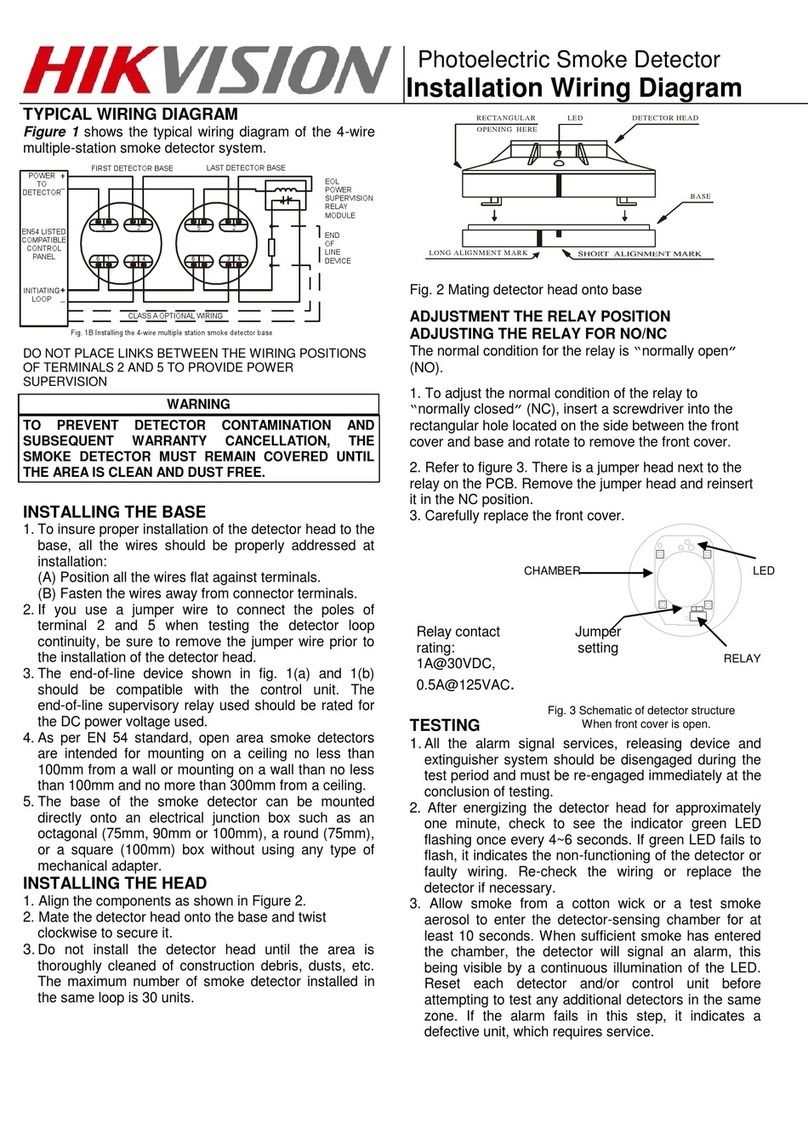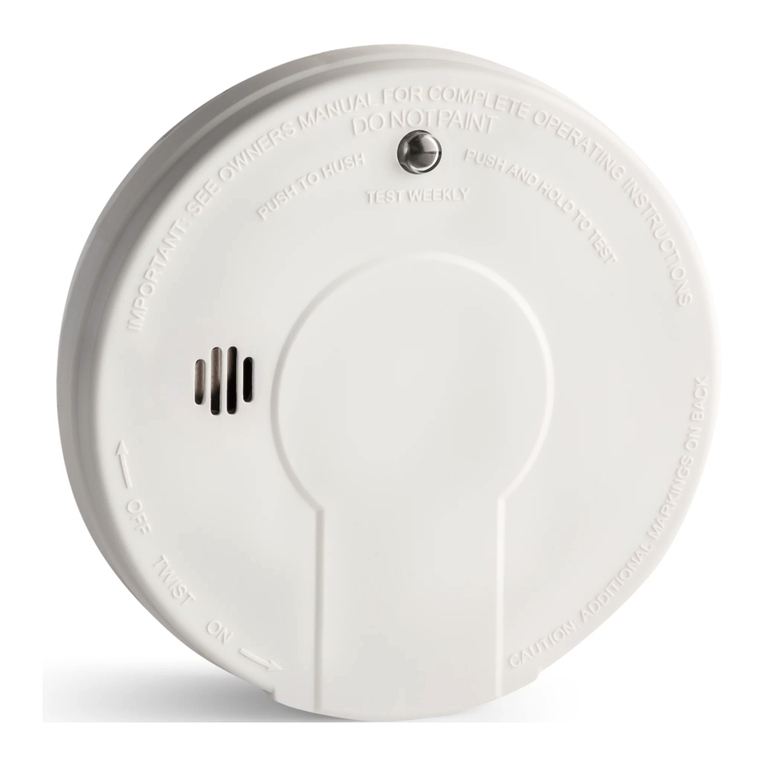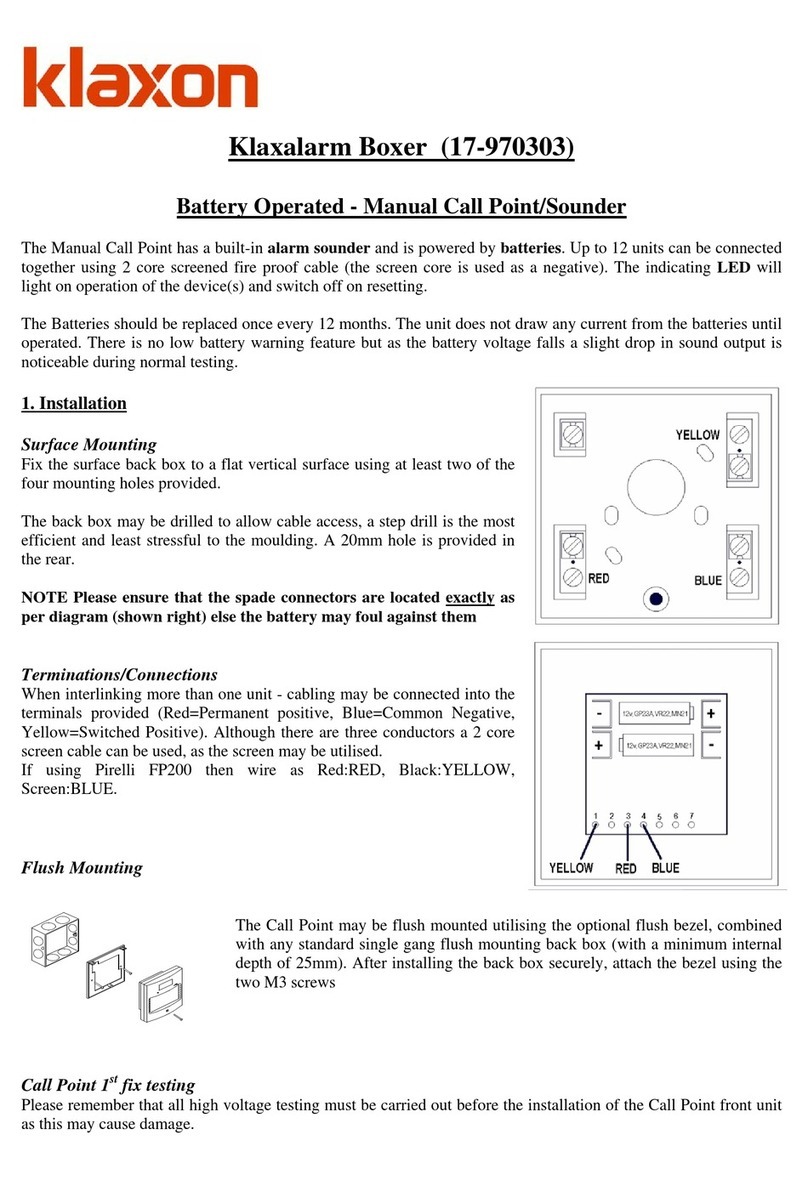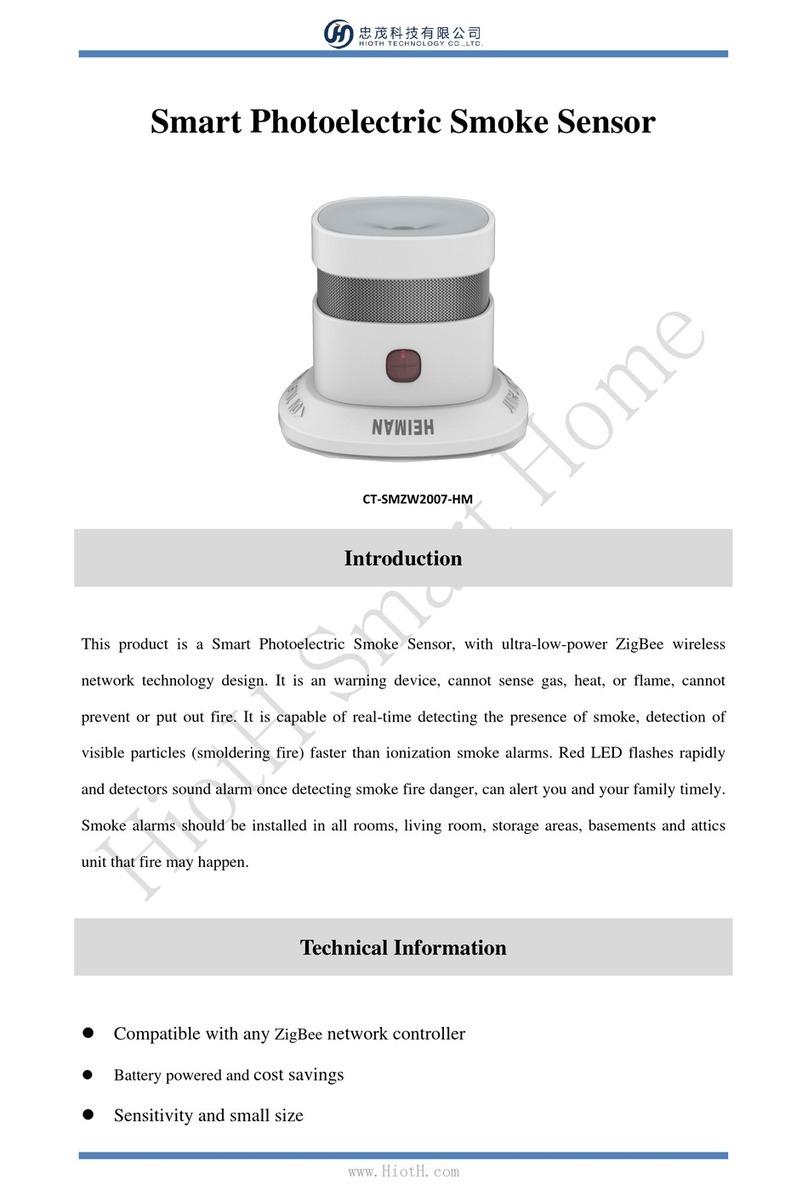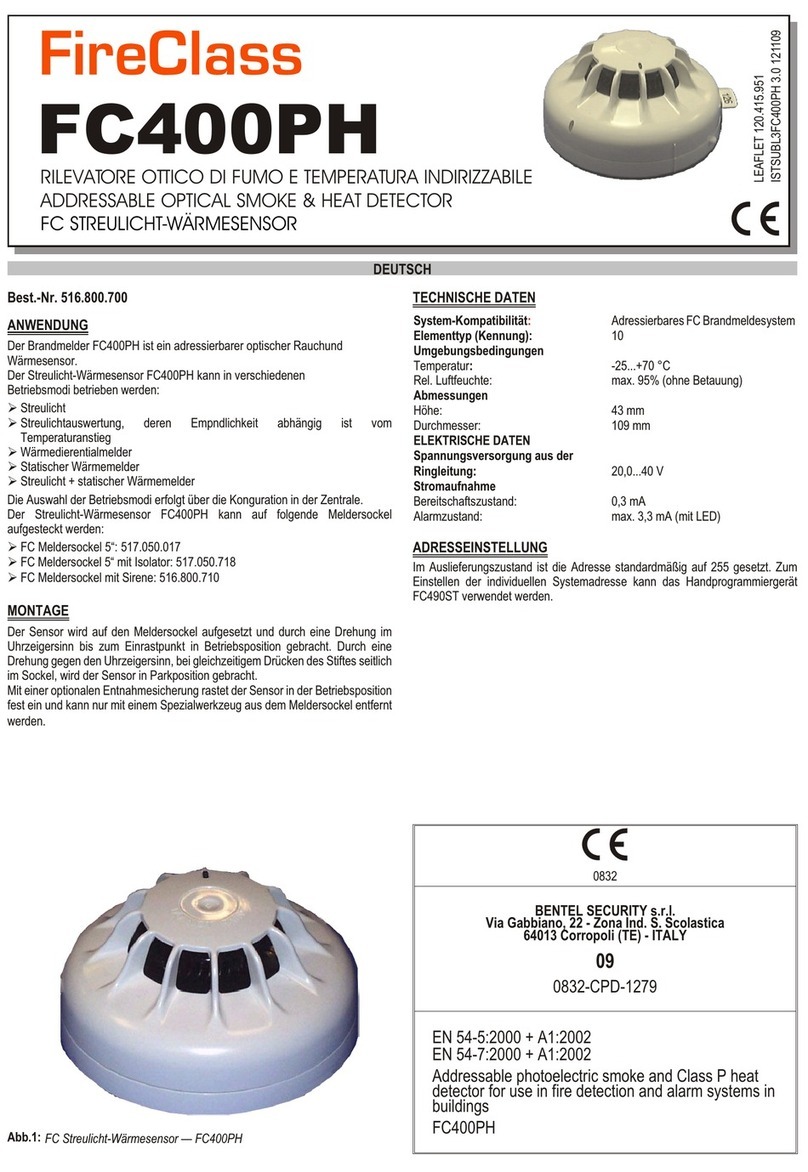Distech Controls GS-SDD Series Manual

Hardware Installation Guide
GS-SDD Series
Duct Smoke Detectors
Figure 1: GS-SDD Series Duct Smoke Detectors
Product Description
This document describes the hardware installation procedures for the
GS-SDD Series duct smoke detectors. They are the latest innovation
for early detection of smoke and products of combustion present in air
moving through HVAC ducts in Commercial, Industrial and Residential
applications.
The GS-SDD Series, 4-wire duct housing will accommodate either the
ionization sensor or the photo electronic sensor. The interchangeable
detector heads allow easy removal for quick cleaning and
maintenance, or a change in application without removing the duct
housing.
The GS-SDD duct smoke detectors sample air currents passing
through a duct and give dependable performance for management of
fans, blowers, and air conditioning systems.
Output terminals are provided for remote accessories such as horns,
strobes, remote status indicators and test/reset key switches or push
buttons.
These duct smoke detectors include many features that represent true
innovations from current generation duct smoke detectors. It is
designed and built to meet all local requirements, as well as the NFPA
regarding duct smoke detectors.
All detectors must be used with a metal sampling tube, model GS-STxx
Series.
Figure 2: GS-STxx Series Sampling Tubes
General Installation Requirements
For proper installation and subsequent operation of each device, pay
special attention to the following recommendations:
- Upon unpacking the product, inspect the contents of the carton for
shipping damages. Do not install damaged device.
- Avoid areas where corroding, deteriorating or explosive vapors,
fumes or gases may be present.
- Ensure that all equipment is installed according to local, regional,
and national regulations.
Personal injury or loss of life may occur if you do not follow a
procedure as specified.
Equipment damage or loss of data may occur if you do not
follow a procedure as specified.
Take reasonable precautions to prevent electrostatic
discharges to the controller when installing, servicing or
operating the controller. Discharge accumulated static
electricity by touching one’s hand to a well-grounded object
before working with the controller.
Mounting Instructions
For the correct installation of a duct smoke unit, please refer to the
NFPA 72E (Standard for Automatic Fire Detectors) and NFPA 90A
(Standard for Installation of Air Condition and Ventilation Systems.)
This detector is not intended for open area protection nor should it be
used for early warning detection or replace a regular fire detection
system.

2/8
The GS-SDD duct smoke detectors are fitted with a mounting base that
will accept 2 models:
- Ionization Detector (GS-SDDI): 4 wire ionization smoke detector
(Listed for high temperature applications)
- Photoelectric Detector (GS-SDDP): 4 wire photoelectric smoke
detector
The duct unit supports 2 sets of form “C” and 1 form “A” Alarm
Contacts and 1 form “C” Trouble Contact. The trouble contact
supervises the presence of the input power and removal of the
detector head.
The trouble contacts (terminals 4-15-5) are shown in the non-
energized condition.
The trouble contact will not operate in the event of a smoke alarm.
The GS-SDD Series will operate on one of the following input voltage
sources: 24VAC, 24VDC, 115VAC and 230VAC.
The duct smoke detector units are designed to operate in duct widths
from 12 inches to 10 feet wide with an air velocity between 100 and
4,000 feet per minute. To verify correct installation, the pressure
differential between the input and exhaust tubes should be measured
using a Magnehelic pressure gauge or equivalent. An acceptable
reading must be between 0.01 and 1.2 inches of water.
For a Smoke Duct Detector unit to operate correctly, it must be
installed 6 duct widths from any obstruction i.e. elbows, deflector
plates, filters, dampers, etc. In situations where the criteria cannot be
met, deviations are acceptable providing they meet the pressure
differential requirements.
Sampling Tubes
The principal of operation of a duct detector is based on the Venturi
effect. Two tubes extend into the HVAC duct. Air flowing through the
duct is forced into the air intake tube via the air intake holes, and
passes over the detector head. The air will be drawn out via the
exhaust tube back into the HVAC duct. (7” exhaust tube provided in
the installation kit.) When the particles of smoke suspended in the air
stream reach the alarm threshold of the detector head, the unit will go
into alarm.
Duct Unit Installation
Duct Smoke Location Prerequisites
This guideline contains general information on duct smoke detector
installation, but does not preclude the NFPA documents listed.
Distech Controls assumes no responsibility for improperly installed
duct detectors. To determine the correct installation position for a GS-
SDD Series Duct Smoke Detector, the following factors must be
considered.
1. A uniform non turbulent airflow of between 100 ft/min to 4,000
ft/min. must be present in the HVAC duct. To determine the
duct velocities examine the engineering specifications that define
the expected velocities or use an Alnor model 6000P velocity/meter
(or equivalent).
2. In order to prevent stratification, duct smoke units, where possible,
must be located a minimum of six duct widths downstream from a
source of turbulence (i.e. elbows, deflector plates, filters, dampers,
and inlets). In installations where it is impossible to adhere to the
six duct width requirement, units can be installed closer but as far
from inlets, bends or deflector plates as possible. Should this
situation arise, check velocity readings in the duct prior to the duct
smoke unit installation. Ensure the duct smoke unit pressure
differential complies with the unit specifications. The pressure
differential between the input sampling tube and exhaust tube for
the GS-SDD series duct smoke unit should be greater than 0.01
inches of water and less than 1.2 inches of water.
3. Identify a location for the installation of the duct unit that will permit
easy access for viewing and serviceability.
4. Install duct units in the return air side of an HVAC unit prior to the
air being exhausted from the building or diluted with outside air.
5. When installing duct smoke units down stream of filters, fires
occurring in the filters will be detected, but If the filters become
blocked insufficient air flow through the duct unit will prevent the
correct operation of the duct detector.
6. Where possible, install duct detectors upstream of air humidifiers
and downstream of dehumidifiers.
7. To prevent false alarms, the duct detector should not be mounted
in areas of extreme high or low temperatures, in areas where high
humidity exists or in areas where the duct may contain gases or
excess dust.
Figure 3. Duct Unit Installation.

3/8
Sampling Tube Assembly
Sampling tubes are to be ordered separately in one of the 4 standard
lengths.
Model
Description
GS-ST01:
Sampling tube duct widths 1' - 2' (10")
GS-ST02:
Sampling tube duct widths 2' - 4' (2.5')
GS-ST05:
Sampling tube duct widths 4' - 8' (5.0')
GS-ST10:
Sampling tube duct widths 8' - 12' (10.0')
The standard sampling tubes are steel tubes with air intake holes
drilled down the entire length of the tube. These tubes must be cut to
length and must span the entire width of the duct. Sampling tubes over
3.0 feet must be supported on the opposite side of the duct. To ensure
the correct operation of the sensing tube, the red end cap (red stopper
in installation kit) must be inserted in the end of the air intake sampling
tube.
Duct Preparation
For ease of duct unit installation, remove mounting template from the
installation kit. Remove paper backing from the mounting template and
affix it to the duct at the desired location. Using the template as a
guide, drill 2 mounting holes (3/32” diam.) for the 12 X 1/2” sheet metal
screws packaged in the installation kit.
Drill or punch 1 1/4” holes for sampling tubes, using the template as a
guide. Clean all holes.
Mounting Duct Smoke Detector
Mount the housing to the duct using 2 #12 x 1/2” sheet metal screws.
Install the intake tube making sure the holes are facing the air flow.
Tighten the latch screw to secure the tube. Install the exhaust tube.
Tighten the latch screw to secure the tube.
Air Sampling Verification
To ensure correct operation of the duct unit use a Magnehelic
differential pressure gauge or Dwyer model 4000 to determine the
differential pressure between the inlet and exhaust tubes. The
differential pressure between the two tubes should be greater than
0.01 inches of water and less than 1.2 inches of water.
This duct smoke detector is shipped with a separate velocity adapter
insert, found in the installation kit.
Installing this adapter will allow the duct detector to operate at
extremely low air velocities - outside of the range referred to in the
attached installation instructions.
To use the adapter, simply insert it into the slots provided inside the
detector housing so that the adapter fits snugly over the smoke
detector head. Unless your system is consistently operating in the
slower velocity range, we recommend that the adapter not be inserted.
If you experience false alarms at higher velocities with the adapter in
place, the adapter should be removed.
Please use the following chart for guidance on when the velocity
adapter should be used. For reference, the speeds indicated are
intended to represent the velocity of air within the duct under normal
operational conditions.
Figure 4. Chart for Guidance on When Velocity Adapter Should be Used.
Electrical Installation
Wiring
Prior to connecting power to the GS-SDD duct units, determine the
correct input voltage and ensure it is connected to the correct
terminals. (Refer to Terminal Connections).
24VAC/DC,Terminals (9, 10);
115VAC, Terminals (115, H, G);
230VAC, Terminals (220, H, G).
Terminal Connections
Figure 5. Terminal Connections.
For terminals (7, 8, 18), (6, 16, 17), (13, 14) do not use
looped wire under terminals. Break wire run to provide
supervision of connections. To test the correct operation of
the duct smoke unit, excluding the detector head (see Test
Procedures) remove detector head and connect one of the
appropriate dedicated power sources to the applicable
terminals (See above). Replace detector head and cover,
the unit will be energized (The green LED will be
illuminated). When pressing the test/reset button the red
alarm LED will be illuminated. In the event of a fire alarm,

4/8
certain equipment may have to be shut down. A shutdown
will be achieved by interrupting the supply source to that
particular piece of equipment when wired as indicated in
Figure 6.
Figure 6. Wiring Example.
Test Procedures
Operational Testing
To determine the correct operation of the GS-SDD Duct Smoke
Detectors, ensure power is connected and the green pilot LED is
illuminated.
The LED on the detector head flashes during the standby mode. The
LED on the detector head will be permanently illuminated when smoke
is detected and the head is in alarm.
With the air handling unit shut down, and the clear cover removed,
press and hold the test/reset button and the cover removal switch on
the GS-SDD Duct Unit. The red alarm LED on the circuit board will be
illuminated and the alarm relay outputs will change state. Using a multi
meter set to OHMS (or continuity buzzer function on the meter) place
the meter probes on the following terminals and ensure the contacts
are closed (continuity) (18, 8), (6,17) when releasing the test/reset
button these contacts will open.
Functional Testing
Once operational, testing is concluded, the unit requires functional
testing to determine the correct operation of the detector head.
Magnet Testing
Place the magnet provided with the instruction kit on top of the housing
between the raised sections above the detector head (as indicated on
the unit cover). Allow at least five (5) seconds for alarm initiation.
Remove magnet and reset detector.

5/8
Smoke Testing
Using smoke test canister with testing nozzle, insert the test gas
nozzle into the test point on the unit cover. Press can against cover to
release gas into chamber.
Do not spray gas for more than 1/2 second. Overuse of test
gas facility will result in detector contamination.
After 15 to 20 seconds the detector head will go into alarm, illuminating
the detector head LED and causing the duct unit functions to operate,
relays will change state and the remote accessories if attached will
function. Please allow several minutes for the gas to evacuate the
chamber before the detector may be reset.
If no test gas is available to conduct the testing, remove cover and,
while holding the cover removal switch, blow smoke from a cotton wick
or punk directly at the head to cause alarm. The alarm indicator will
illuminate within one minute.
Should testing be required for simulated fire conditions, smoke bombs
placed in the duct may not be suited for the particular detector head
selected and installed.
Ionization Detector (GS-SDDI) utilizes a radioactive source as its
means of detection and will detect smoke particles of between .1 and 1
micron in size.
Photoelectric Detector (GS-SDDP) operates on the principle of light
scatter and will detect smoke particles of between 1 and 10 microns in
size.
When purchasing smoke bombs for functional testing, ensure smoke
particle sizes comply with the criteria as described above.
Maintenance
Each installation location must be assessed on its own merits. If the
protected area is of a very dirty nature then the GS-SDD Duct units will
have to be checked and cleaned on a quarterly basis or when cleaning
is required.
As a guideline the detector head should be cleaned every six (6)
months or as required. The best methods of cleaning are to vacuum
the detector head thoroughly or to blow the detector head out using
compressed air. Do not use chemicals to clean the detector head
housing as this could contaminate the detector head and damage the
casing. Sensing tubes must be inspected and cleaned in accordance
with the schedule as determined above, to allow the free flow of air
through the sensing tube.
Dimensions
Figure 7. Dimensions for the GS-SDD Series Duct Smoke Detectors

6/8
Remote Accessory Wiring
Figure 8.
Figure 9.
Fire Alarm Control Panel Wiring
Figure 10.

7/8
Figure 11.

©, Distech Controls Inc., 2014. All rights reserved.
While all efforts have been made to verify the accuracy of information in this manual, Distech Controls is not responsible for damages or claims arising from the use of this
manual. Persons using this manual are assumed to be trained HVAC specialist / installers and are responsible for using the correct wiring procedures and maintaining safe
working conditions with fail-safe environments. Distech Controls reserves the right to change, delete or add to the information in this manual at any time without notice.
Distech Controls, the Distech Controls logo, and Innovative Solutions for Greener Buildings are trademarks of Distech Controls Inc. All other trademarks are property of their
respective owners.
8/8
GS-SDD Series_IG_10_EN
Detector Interconnection Wiring Common Functions
Figure 12.
Table of contents

